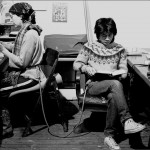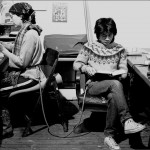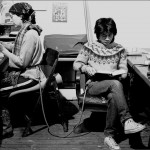Jumping from “Frame” to “Relation” we can consider Stan Douglas’ 1992 work, “Hors Champs” in which both questions of the frame/out of frame, and a relation, in this case, the two sides of a screen (and attendant cultural specifics the work brings up, around race, nation, improvisation, music and television).
Scott Watson writes: In Hors-Champs, originally made for the Centre Georges Pompidou in Paris, and restaged at Documenta — the international salon of contemporary art held every five years in Kassel, Germany — a paper-thin screen hangs in the middle of an empty room. Scenes from what appears to be a historic studio jazz session are projected on both sides. The music we hear is Albert Ayler’s 1965 composition, ‘Spirits Rejoice’, a jazz piece that uses recognizable citations from ‘La Marseillaise’ and ‘Maryland, My Maryland’, both hymns to the revolutionary spirit of modernity’s oldest republics: France and America. The music combines the intellectual atonality of high modernism — and thus the themes of exile, alienation and disintegration — with the free jazz rhythms favoured by the African-American musicians living in Paris in the nineteen-sixties. Always marginal to more popularly accepted forms of jazz, free jazz was abandoned as the idealism of the sixties clouded over.
For one side of the screen, Douglas created a simulated documentary video, the sort of thing that might have been produced for television in the sixties. The camera tracks the jazz musicians as they take up the themes of the piece and play their instruments. The other side shows what might have been out-takes, dwelling on players at rest and the spaces between them.
Viewing Hors-Champs is a frustrating experience. There is no easy ready-made space for the viewer to inhabit, no single vantage point from which the viewer perceives the scene. The two sides of the screen do not, like Michael Snow’s double-sided screenworkTwo Sides to Every Story (1974), present the recto and verso of the same situation. In Hors-Champs, you can’t infer from one side what is happening on the other; neither can you experience both sides simultaneously. The work thus represents the antithesis of single-point Renaissance perspective. As the music is taken up by one player, then another, the viewer feels obliged to move from side to side in an effort to come to some understanding, embodying the contradictions between European modernism and Afro-American culture that the music attempts to synthesize.
from http://www.ccca.ca/c/writing/w/watson/wat004t.html
Monika Sosnowska

Monika Sosnowska, on the relations in her zig zag sculptural exhibition design for, “The Promises of the Past” Centre Pompidou, Paris, 2010 (from Artforum “1000 Words”, available here) The exhibition grew, works were added, the narrative kept being redefined, and because the works were all interconnected—organically linked with everything else through this zigzagging structure—even the smallest change meant the entire thing had to be modified. This is not a geometry that I devised for aesthetics’ sake, to give the form an interesting look. It’s responsive, reactive—it reflects the fact that some adjoining works have to be separated from each other, located on the opposite sides of an acute angle, while others need to confront each other or be juxtaposed. It’s related to the curatorial concept that the exhibition brings together the works of artists from different generations and countries, artists whose practices could be seen as parallel even if they never actually met (the borders inside Eastern Europe were sometimes much stricter than those between East and West).
THOMAS HIRSCHHORN
Thomas Hirschhorn, “Crystal of Resistance”, 2011, Swiss Pavilion, Venice Biennale, Venice, Italy, 2011;
Hirschorn’s website and statement: http://www.crystalofresistance.com/statement.html
Frances Alys

The Green Line (Sometimes doing something poetic can become political and sometimes doing something political can become poetic)
2005
Video projection, 2 hard drives, touch screen, 5 mdf tables, 10 lamps, framed map, works on paper, photocollages, 1 painting, 1 wood gun sculpture
Marcel Duchamp

Bicycle Wheel, 1913/1951
http://www.moma.org/collection/object.php?object_id=81631
Greg Wilson, Silent Disco, Tate Liverpool
Soundtrack music in films (for instance) functions to create unit across a scene or several scenes. Here it creates a relation and a disjunction as the music is on headphones only.
Artists Tehching Hsieh and Linda Montano spent one year between 4 July 1983 and 4 July 1984 tied to each other with an 8-foot-long (2.4 m) rope. They had to stay in a same room while not allowed to touch each other until the end of the one year period.
http://www.one-year-performance.com/



